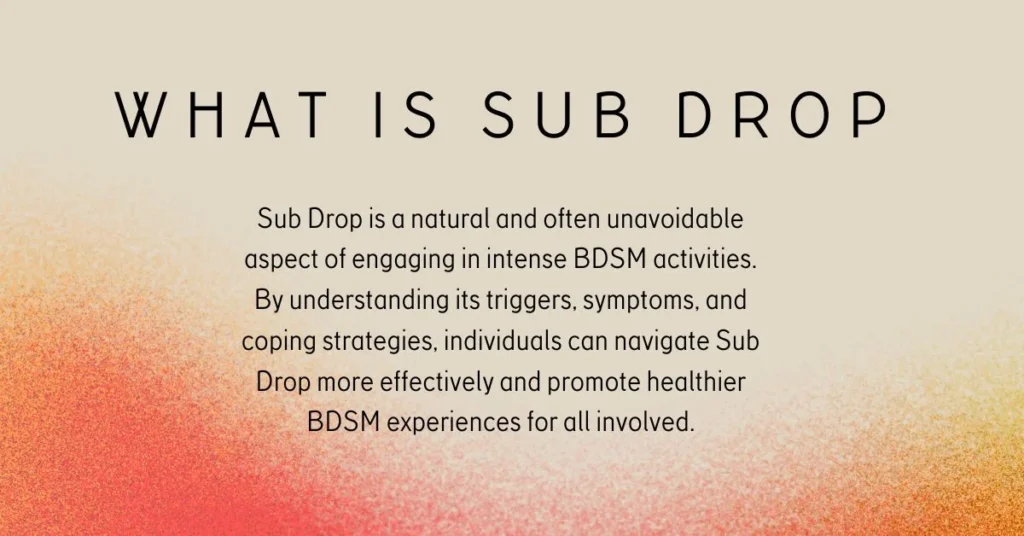Introduction to Sub Drop
The world of BDSM can be an exhilarating journey, filled with passion, trust, and exploration. But what happens when the adrenaline fades and reality sets in? Enter the intriguing phenomenon known as sub drop. For many involved in power exchange dynamics, this emotional and physical shift can catch them off guard after intense scenes. If you’re curious about what sub drop is or how it affects your experience in kink, you’re not alone. Understanding this aspect of BDSM is crucial for a fulfilling and safe practice. Let’s dive into the complexities of sub drop to shed light on its impact and how to navigate through it effectively.
Understanding the Aftermath of Intense Scenes
The aftermath of intense scenes can evoke a complex mix of emotions. After the adrenaline rush fades, many people find themselves in a vulnerable state. The high-energy moments that once fueled excitement can lead to unexpected emotional lows.
This shift is not uncommon within BDSM dynamics or any scenario involving deep trust and connection. It’s essential to recognize that these feelings are part of the experience. They often reflect the intensity of vulnerability shared during play.
Physical sensations may linger too, like fatigue or muscle soreness from exertion. These physical responses can amplify emotional shifts, making it crucial to address them holistically.
Understanding this process helps cultivate deeper connections between partners. It opens up conversations about needs and boundaries while enhancing overall experiences in future sessions. Acknowledging the complexities allows for healthier relationships both during and after intense interactions.
Explain of “what is sub drop”?
Sub drop is a phenomenon often experienced by submissives after intense BDSM scenes. It refers to the emotional and physical low that can occur following moments of heightened arousal, connection, or vulnerability.
When engaging in heavy play, the body releases a rush of hormones like adrenaline and endorphins. Once the scene ends, this chemical surge quickly dissipates. The resulting shift can lead to feelings of sadness or anxiety.
It’s essential to recognize that sub drop isn’t universal. Not everyone will experience it after every session, but those who do might find themselves feeling detached or overwhelmed.
The intensity of the experience directly impacts how pronounced these feelings may be. Understanding sub drop helps both partners navigate its effects and creates an opportunity for deeper intimacy post-scene.
Symptoms of Sub Drop
Sub drop manifests in various emotional and physical symptoms. You might feel sudden waves of sadness or anxiety after an intense scene. It’s not uncommon to experience feelings of emptiness or fatigue.
Some people report unexpected mood swings, shifting from euphoria to despair within moments. This rollercoaster can be confusing and overwhelming.
Physical sensations may also arise. You could notice tension in your muscles or a general sense of lethargy that lingers longer than you’d expect.
Sleep disturbances are another symptom; many find it hard to settle into restful sleep following such experiences.
Additionally, irritability might set in as the body adjusts back to its normal state. Recognizing these signs early can help manage sub drop effectively.
Coping Mechanisms for Sub Drop
Coping with sub drop requires a blend of self-care and communication. First, prioritize rest. Your body needs time to recuperate after intense scenes.
Hydration and nutrition play vital roles as well. Eating nourishing foods can help stabilize your mood and energy levels.
Engaging in light physical activity, like yoga or walking, can release endorphins. These natural chemicals elevate your mood and combat feelings of sadness or anxiety.
Reach out to friends or community members who understand the lifestyle. Sharing experiences can provide comfort and reassurance during tough times.
Journaling is another effective tool. Writing down thoughts helps process emotions, making them easier to manage.
Consider mindfulness techniques such as deep breathing or meditation. These practices ground you in the present moment and reduce overwhelming feelings that often accompany sub drop.
Communicating with Your Partner about Sub Drop
Open and honest communication is essential when navigating the complexities of sub drop. It’s crucial to discuss your feelings openly with your partner. Share what you experience emotionally and physically after intense scenes. This dialogue helps foster understanding.
Choose a calm moment, away from high emotions, to talk about it. Expressing vulnerability can be daunting but builds trust between partners. Encourage them to share their perspectives too, as this promotes mutual support.
Use “I” statements to communicate how sub drop affects you personally. For example, saying “I feel drained” rather than “You make me feel drained” minimizes defensiveness and encourages empathy.
Regular check-ins about emotional well-being can strengthen your connection over time. Creating a safe space for such discussions ensures both partners are on the same page regarding needs and expectations during these intimate journeys together.
How to Prevent or Minimize Sub Drop?
Preventing or minimizing sub drop involves a blend of preparation, communication, and self-care. Before engaging in intense scenes, ensure that you set clear boundaries and establish safe words. This creates a strong foundation for trust.
Aftercare is crucial. Allocate time for emotional support post-scene to help transition back to reality. Snuggling, discussing feelings, or simply enjoying quiet moments can be incredibly healing.
Hydration and nutrition also play significant roles. Drink water and eat nourishing foods before and after sessions to maintain energy levels.
Reflect on your experiences by journaling about what worked well and what didn’t. This can offer valuable insights into your emotional responses.
Consider establishing regular check-ins with your partner about your feelings outside of the scene dynamics. Open dialogue fosters understanding and strengthens connections while allowing both partners to navigate any potential emotional turbulence together.
Conclusion
Navigating the emotional landscape following intense BDSM scenes can be challenging. Understanding what sub drop is, and recognizing its symptoms, allows for better preparation and communication within relationships. By implementing coping strategies and ensuring open dialogue with your partner, you can create a safer environment that minimizes discomfort.
Honesty about feelings and experiences enhances trust in your dynamic. Remember the importance of care both during and after scenes to foster deeper connections. With awareness and support, managing sub drop becomes a shared journey rather than an isolated experience.
As you explore this fascinating realm, prioritize self-care practices that enrich not just your play but also your overall well-being. Embrace the intensity while remaining grounded in safety and connection—after all, it’s all part of a fulfilling exploration into pleasure and trust.
YOU MUST READ: A Deep Dive into ‘cat in the chrysalis spoiler’
FAQs
What is “sub drop”?
Sub drop is the emotional and physical low some submissives experience after intense BDSM scenes, often caused by a sudden drop in adrenaline and endorphins.
Can sub drop affect someone even after a positive scene?
Yes, sub drop can occur regardless of whether the scene was enjoyable—it’s a physiological and emotional response to intensity, not dissatisfaction.
How long does sub drop typically last?
Sub drop can last anywhere from a few hours to several days, depending on the individual, scene intensity, and emotional resilience.
Does everyone in BDSM experience sub drops?
No, not everyone experiences sub drops. Some may never feel it, while others might encounter it frequently depending on the emotional depth of the play.
Is aftercare necessary to prevent sub drops?
While it may not prevent sub drops entirely, proper aftercare—such as cuddling, hydration, and emotional check-ins—can significantly reduce its severity and duration.






